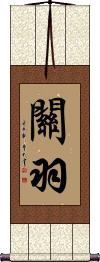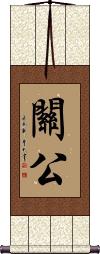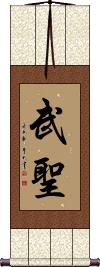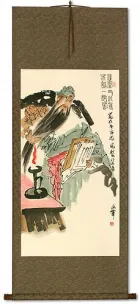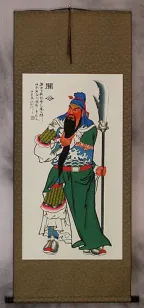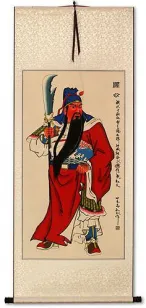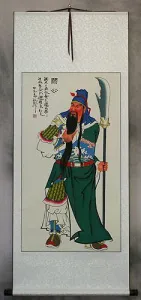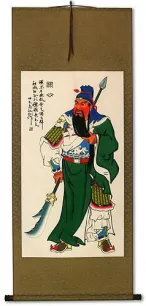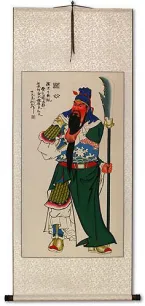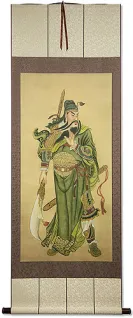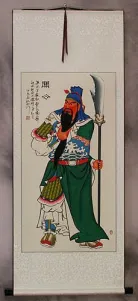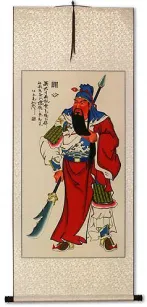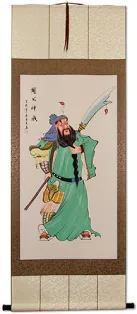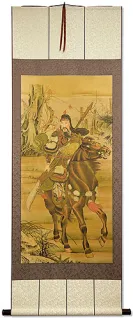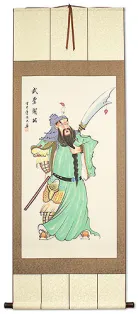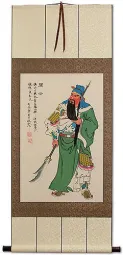Many custom options...
And formats...

Guan Yu in Chinese / Japanese...
Buy a Guan Yu calligraphy wall scroll here!
Personalize your custom “Guan Yu” project by clicking the button next to your favorite “Guan Yu” title below...
Guan Yu
關羽 is the name Guan Yu, Army General for the Kingdom of Shu.
He is also known as Guan Gong (like saying Duke Guan or Sir Guan)
He was immortalized in the novel, “Romance of the Three Kingdoms.”
He was a fearsome fighter, also famous for his virtue and loyalty. He is worshiped by some modern-day soldiers and has the title “Warrior Saint” in China. Some believe he offers safety and protection for military servicemen.
Guan Yu lived until 219 A.D.
Guan Gong / Warrior Saint
關公 is a Chinese title, Guan Gong, that means Lord Guan (The warrior saint of ancient China).
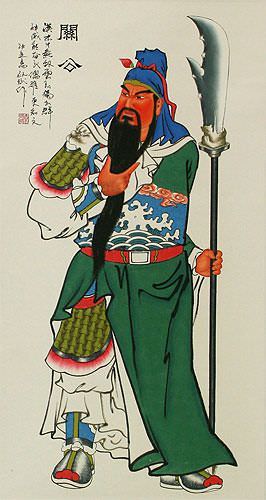 While his real name was Guan Yu / 關羽, he is commonly known by the title of Guan Gong (關公).
While his real name was Guan Yu / 關羽, he is commonly known by the title of Guan Gong (關公).
Some Chinese soldiers still pray to Guan Gong for protection. They would especially do this before going into battle. Statues of Guan Gong are seen throughout China.
Warrior Saint / Saint of War
This in-stock artwork might be what you are looking for, and ships right away...
Guan Gong Warrior Saint On Horseback
Large Wall Scroll
Discounted Blemished
Gallery Price: $71.00
Your Price: $39.00
Gallery Price: $200.00
Your Price: $79.88
Gallery Price: $200.00
Your Price: $79.88
Gallery Price: $200.00
Your Price: $79.88
Gallery Price: $200.00
Your Price: $79.88
Gallery Price: $144.00
Your Price: $79.88
Not the results for Guan Yu that you were looking for?
Below are some entries from our dictionary that may match your Guan Yu search...
| Characters If shown, 2nd row is Simp. Chinese |
Pronunciation Romanization |
Simple Dictionary Definition |
武聖 武圣 see styles |
wǔ shèng wu3 sheng4 wu sheng |
More info & calligraphy: Warrior Saint / Saint of War |
關羽 关羽 see styles |
guān yǔ guan1 yu3 kuan yü |
More info & calligraphy: Guan Yu |
龐德 庞德 see styles |
páng dé pang2 de2 p`ang te pang te |
More info & calligraphy: Ponder |
光宇 see styles |
guanyu ぐあんゆ |
(personal name) Guan'yu |
五虎將 五虎将 see styles |
wǔ hǔ jiàng wu3 hu3 jiang4 wu hu chiang |
Liu Bei's five great generals in Romance of the Three Kingdoms, namely: Guan Yu 關羽|关羽, Zhang Fei 張飛|张飞, Zhao Yun 趙雲|赵云, Ma Chao 馬超|马超, Huang Zhong 黃忠|黄忠 |
桃園三結義 桃园三结义 see styles |
táo yuán sān jié yì tao2 yuan2 san1 jie2 yi4 t`ao yüan san chieh i tao yüan san chieh i |
Oath of the Peach Garden, sworn by Liu Bei 劉備|刘备[Liu2 Bei4], Zhang Fei 張飛|张飞[Zhang1 Fei1] and Guan Yu 關羽|关羽[Guan1 Yu3] at the start of the Romance of Three Kingdoms 三國演義|三国演义[San1 guo2 Yan3 yi4] |
The following table may be helpful for those studying Chinese or Japanese...
| Title | Characters | Romaji (Romanized Japanese) | Various forms of Romanized Chinese | |
| Guan Yu | 關羽 关羽 | guān yǔ / guan1 yu3 / guan yu / guanyu | kuan yü / kuanyü | |
| Guan Gong Warrior Saint | 關公 关公 | guān gōng guan1 gong1 guan gong guangong | kuan kung kuankung |
|
| Warrior Saint Saint of War | 武聖 武圣 | wǔ shèng / wu3 sheng4 / wu sheng / wusheng | ||
| In some entries above you will see that characters have different versions above and below a line. In these cases, the characters above the line are Traditional Chinese, while the ones below are Simplified Chinese. | ||||
Successful Chinese Character and Japanese Kanji calligraphy searches within the last few hours...
